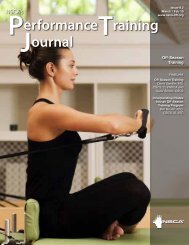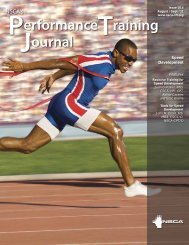PTJ Sep Oct 2010.pdf
PTJ Sep Oct 2010.pdf
PTJ Sep Oct 2010.pdf
You also want an ePaper? Increase the reach of your titles
YUMPU automatically turns print PDFs into web optimized ePapers that Google loves.
feature<br />
about the<br />
AUTHOR<br />
David J. Szymanski,<br />
PhD, CSCS,*D, is an<br />
Assistant Professor of<br />
exercise physiology,<br />
Director of the Applied<br />
Physiology Laboratory,<br />
and the Head Strength<br />
& Conditioning Coach<br />
for the Baseball<br />
team at Louisiana<br />
Tech University.<br />
Dr. Szymanski is a<br />
Certified Strength and<br />
Conditioning Specialist<br />
with Distinction and<br />
a Registered Coach<br />
with the NSCA. In<br />
1997, he was apart of<br />
the Auburn baseball<br />
team that went to<br />
the NCAA College<br />
World Series. Before<br />
attending Auburn<br />
University, where he<br />
earned a doctorate in<br />
exercise physiology,<br />
Dr. Szymanski was<br />
the Assistant Baseball<br />
Coach and Weight<br />
Room Director at Texas<br />
Lutheran University for<br />
5 years. His primary<br />
research has focused<br />
on ways to improve<br />
baseball performance.<br />
Dr. Szymanski can<br />
be contacted at<br />
dszyman@latech.edu.<br />
General, Special, and<br />
Specific Core Training<br />
for Baseball Players<br />
David J. Szymanski, PhD, CSCS,*D<br />
When conditioning baseball players, the importance of<br />
core training and its effect on improving performance<br />
should be emphasized. Core training predominantly<br />
consists of torso or trunk (rectus abdominus, external<br />
obliques, internal obliques, and transverse abdominus)<br />
training, but also includes the stabilizing muscles of the<br />
hips, lumbar, thoracic, and cervical spine. When designing<br />
a baseball-specific core exercise program, a variety of<br />
exercises requiring the athlete to move dynamically in all<br />
three planes (frontal, sagittal, and transverse) of human<br />
movement should be included. Frontal plane movements<br />
involve lateral flexion and bending on both sides of the<br />
body. Sagittal plane movements involve flexion and extension<br />
of the trunk in forward and backward movements.<br />
Transverse plane movements involve rotation or twisting<br />
on both sides of the body.<br />
Baseball movements occur through sequential, coordinated<br />
muscle contractions that require timing and balance.<br />
The system by which this occurs is called the kinetic<br />
link. If the multi-planar human movements are not coordinated<br />
to allow the forces generated from the lower<br />
body to be transferred through the torso to the arms, then<br />
baseball performance (hitting and throwing) will not be<br />
optimal. It is often said that the weak link in the human<br />
body is the torso since it may not be trained properly, or<br />
sport-specifically. If training for the torso is not geared at<br />
developing core strength and power in hitting and throwing,<br />
a player’s performance may not be optimal and there<br />
may be a greater likelihood of sustaining an injury. Torso<br />
contributions are vital for both the execution of high bat<br />
swing and throwing velocities, and for improving bat<br />
swing and throwing velocities within individual players.<br />
Thus, enhancing core performance utilizing strength and<br />
power training should maintain and may even improve<br />
bat swing and throwing velocities depending on the maturation,<br />
initial strength, resistance training experience,<br />
and baseball skills of individual players.<br />
core training<br />
There are four different phases of an annual periodized<br />
program. They are off-season, preseason, in-season, and<br />
active rest. Off-season and preseason core training will be<br />
addressed in this article for the baseball player. In order<br />
to improve core performance, strength training professionals<br />
can implement general, special, and specific exercises<br />
into a progressive periodized program. Progression<br />
means incorporating movements from simple to complex,<br />
known to unknown, low force to high force, static to<br />
dynamic, lying to sitting, kneeling to standing, and on two<br />
legs to standing on one leg.<br />
General core exercises would be traditional abdominal,<br />
oblique, lower back exercises, pillar bridges, and some<br />
lower body multi-joint exercises. Traditional trunk exercises<br />
are routinely performed slowly with greater volume<br />
during the off-season when athletes are attempting to<br />
develop core muscular endurance and hypertrophy. As<br />
the off-season progresses towards the preseason, traditional<br />
trunk exercises are performed with resistance to<br />
develop muscular strength. Pillar bridge exercises require<br />
an athlete to isometrically stabilize the trunk in prone or<br />
lateral positions. Furthermore, multi-joint resistance training<br />
exercises such as the squat, good mornings and deadlifts<br />
can improve core strength. The activation of trunk<br />
muscles while executing a squat or deadlift exercise may<br />
be greater or equal to is the activation produced during<br />
stability ball exercises. Stability exercises, such as pillar<br />
bridges, may not need to be performed if athletes are<br />
squatting and deadlifting with loads greater than 80% of<br />
their 1-repetition maximum. An example of the first two<br />
weeks of a six-week general trunk exercise program can<br />
be found in Table 1. An example of the first two weeks of<br />
a six-week general weighted trunk exercise program can<br />
be found in Table 2.<br />
nsca’s performance training journal • www.nsca-lift.org • volume 9 issue 5 13





